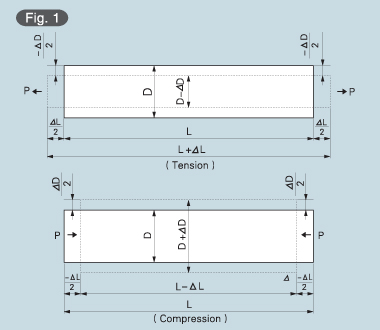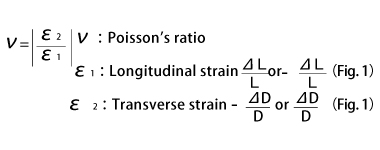Strain, Stress and Poisson`s Ratio
When a material receives a tensile force P, it has a stress that corresponds to the applied force. In proportion to the stress, the cross section contracts and the length elongates by ź─L from the length L the material had before receiving the tensile force (see illustration in Fig. 1) below.
The ratio of the elongation to the original length is called a tensile strain and is expressed as follows:
See the lower illustration in Fig. 1. If the material receives a compressive force, it bears a compressive strain expressed as follows:
For example, if a tensile force makes a 100 mm long material elongate by 0.01 mm, the strain initiated in the material is as follows:
Thus, strain is an absolute number and is expressed with a numeric value with x10 -6 strain, źņźÕ or źņm/m suffixed. Based on Hooke's law, the relation between stress and the strain initiated in a material by an applied force is expressed as follows:
Stress is thus obtained by multiplying strain by the Young's modulus. When a material receives a tensile force P, it elongates in the axial direction while contracting in the transverse direction. Elongation in the axial direction is called longitudinal strain and contraction in the transverse direction, transverse strain. The absolute value of the ratio between the longitudinal strain and transverse strain is called Poisson's ratio, which is expressed as follows:
Poisson's ratio differs depending on the material.















 TOP
TOP